Key takeaways:
- The death penalty raises ethical questions about justice and humanity, challenging perceptions of deterrence versus inhumanity.
- Visits to death row facilities reveal the complex human stories of inmates, highlighting the importance of compassion and understanding over mere judgment.
- Conversations with inmates demonstrate their humanity and emotions, offering insights into their lives beyond their crimes and the potential for redemption.
- Reflecting on these experiences emphasizes the need to balance justice with empathy, recognizing that each individual’s story is multifaceted.
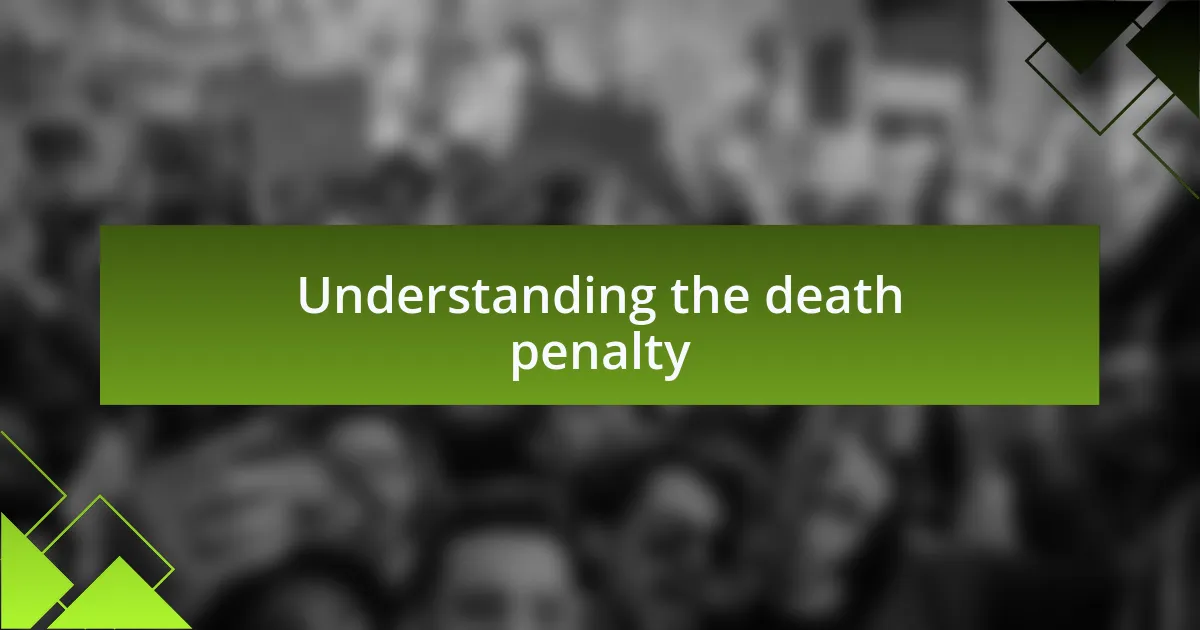
Understanding the death penalty
The death penalty, often viewed as a form of justice, raises profound ethical questions. I often find myself wondering, what truly makes us believe that taking a life can right a wrong? It’s a harrowing concept that invites us to examine not just the crimes committed, but also the very nature of humanity and justice itself.
From my experiences, visiting death row facilities opened my eyes to the complexity of this issue. Standing in a confined space, I felt the weight of decisions that affect countless lives – both the convicted and their families. I couldn’t shake the feeling that each person behind those bars had a story, a life filled with nuances that the public rarely considers.
What strikes me is the stark contrast in public perception; many see the death penalty as a necessary deterrent, while others view it as inhumane. It’s crucial, then, to ask ourselves: can we truly measure the value of life through the lens of retribution? Engaging with differing viewpoints not only deepens our understanding but also challenges us to reconsider our stance on such a divisive issue.

Arguments against the death penalty
Many argue against the death penalty by highlighting its irrevocability. The notion that an innocent person can be wrongfully executed is a chilling thought that haunts me. I recall a case I studied where new evidence emerged years after a conviction, proving the defendant’s innocence. How can we accept a system that allows such tragedies to occur?
Another compelling argument I’ve encountered revolves around the disproportionate impact on marginalized communities. I’ve seen how the scales of justice seem to tip unfairly, with people from low-income backgrounds facing harsher sentences. This disparity makes me question whether our justice system truly serves all citizens equally or simply reflects societal biases.
Moreover, the death penalty does not demonstrate a significant deterrent effect on crime rates. In conversations with law enforcement officials, I’ve learned that factors like socioeconomic circumstances play a far greater role in crime than the threat of capital punishment. This raises an important question: if the death penalty doesn’t effectively prevent crime, what purpose does it truly serve?
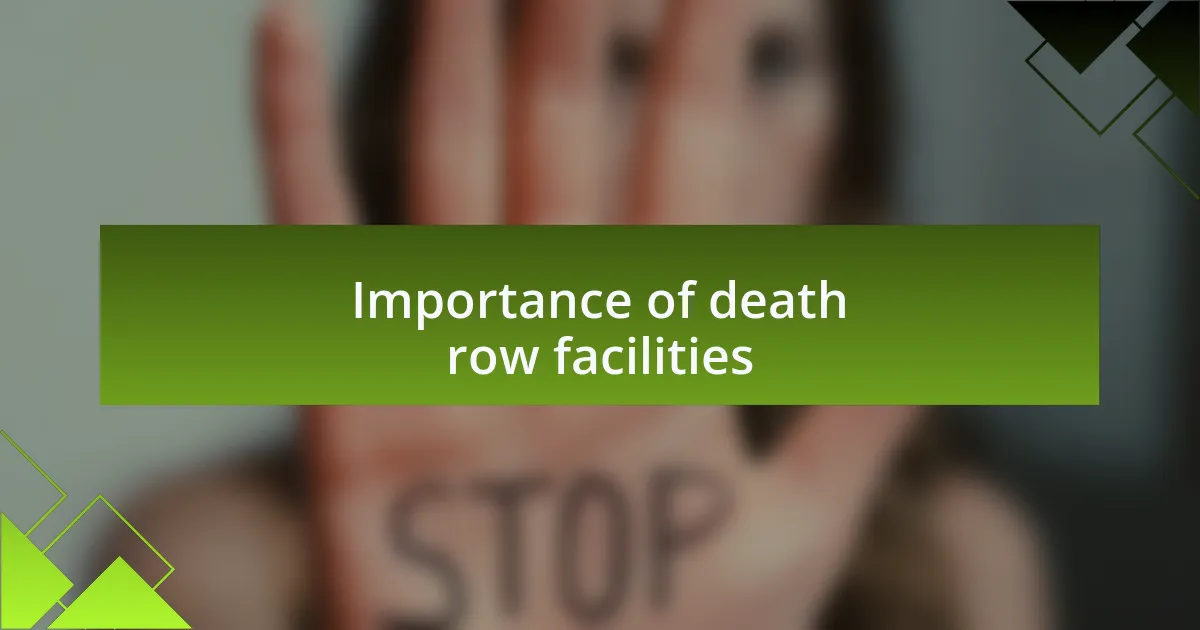
Importance of death row facilities
The death row facility plays a critical role in our justice system by providing a space for careful reflection on the consequences of capital punishment. During my visit, I was struck by the somber atmosphere that enveloped the place. It made me ponder the weight of life and death decisions. Each inmate’s story is a reminder of the complexity of human behavior; it forces us to confront not just punishment, but also redemption and justice.
Moreover, death row facilities are essential for ensuring that due process is adhered to before carrying out the ultimate penalty. I remember feeling a profound sense of responsibility wash over me as I stood in that stark environment, recognizing the meticulous legal safeguards in place. It raises an essential question: without these facilities, how do we guarantee that every aspect of a case has been thoroughly examined?
Finally, the presence of death row often sparks crucial conversations about morality and ethics in our society. Engaging with the staff and inmates, I felt a mix of sadness and hope, realizing how these interactions can influence public opinion. Could it be that visiting these facilities opens up paths for understanding and reform in a deeply flawed system?
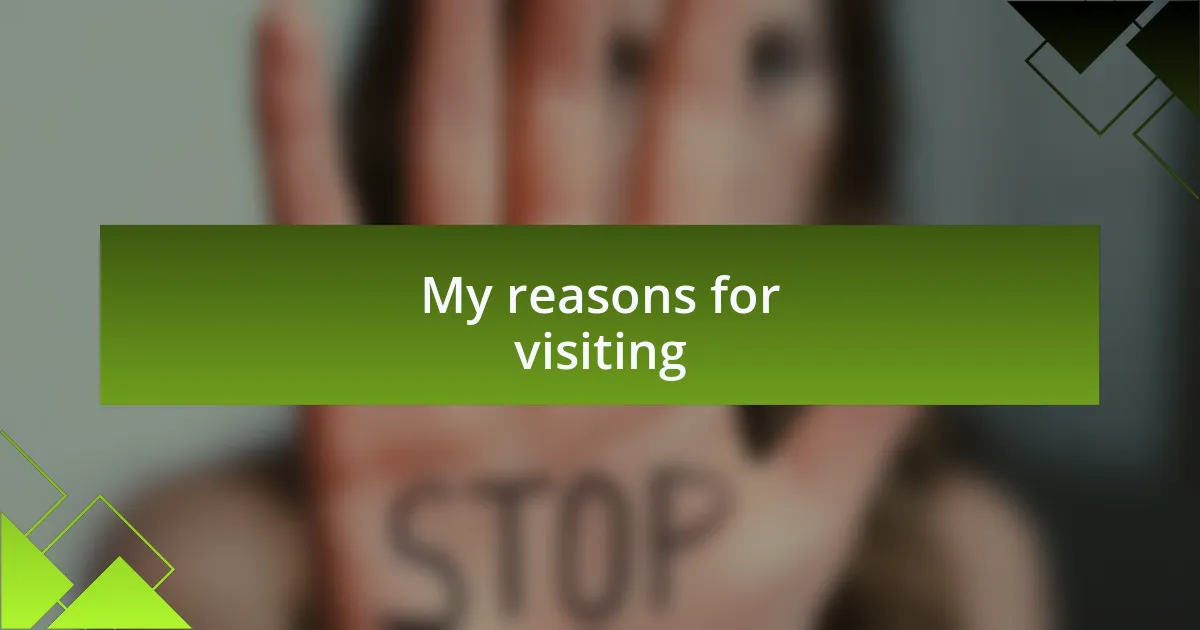
My reasons for visiting
Visiting the death row facility was a deeply personal decision for me. I’ve always believed that understanding comes from experience, not just statistics. As I walked through the halls, I felt an overwhelming sense of connection to those who had spent years confined there, pondering the stories behind their circumstances. How could I advocate for change without truly understanding their lives and their choices?
One of my driving reasons for visiting was to witness the human side of those on death row. I remember sitting across from an inmate during a conversation, and I could see the flicker of hope in his eyes. It was a stark reminder that, despite the gravity of their actions, these individuals are still humans deserving of compassion. Each story I heard made me question how our society approaches justice. Are we too quick to cast judgment without seeing the full picture?
Additionally, I felt a strong need to confront my own beliefs about capital punishment. This journey wasn’t just about gathering information; it was about wrestling with my ethics and emotions. Engaging with both inmates and advocates pushed me beyond theoretical discussions into a realm of real stories and emotions. How can we truly advocate for reform if we don’t grapple with our own perspectives? This visit fueled my determination to foster awareness and spark dialogue about the complexities of death row.
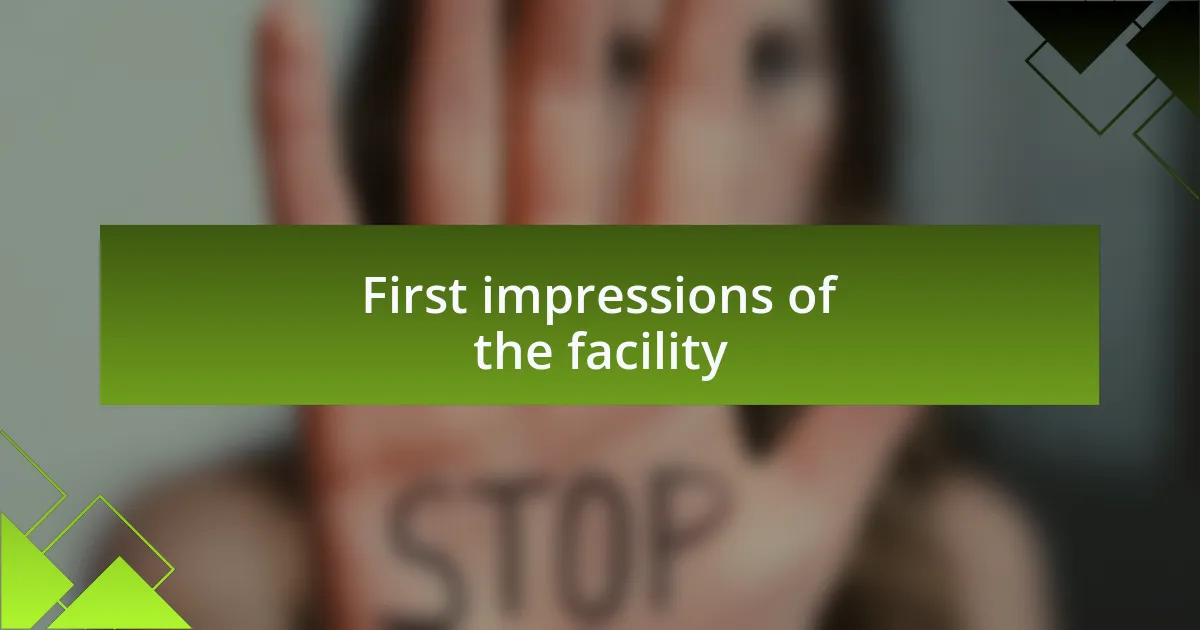
First impressions of the facility
Stepping into the death row facility for the first time was an experience that caught me off guard. The starkness of the surroundings hit me like a cold wave—grey concrete walls and heavy doors that echoed with each closed latch. I couldn’t help but wonder how many souls had walked those same halls, each carrying stories that painted a broader picture of human experience.
As I navigated through the corridors, an uneasy weight settled in my chest. The atmosphere was thick with history and unspoken pain. I found myself pausing at the windows, looking out into the exercise yard, imagining the fleeting moments of sunlight that inmates must crave. It made me ask—what does freedom truly mean when it’s so far removed from reality?
I vividly recall the moment I encountered one of the guards. His demeanor was serious, yet his eyes betrayed a hint of weariness that suggested he, too, wrestled with the implications of his job. It raised those uncomfortable questions in my mind: How did he reconcile his role in this system? In that instant, I realized this facility wasn’t just about the inmates but also about everyone involved in the machinery of capital punishment, each person carrying their burdens and beliefs.
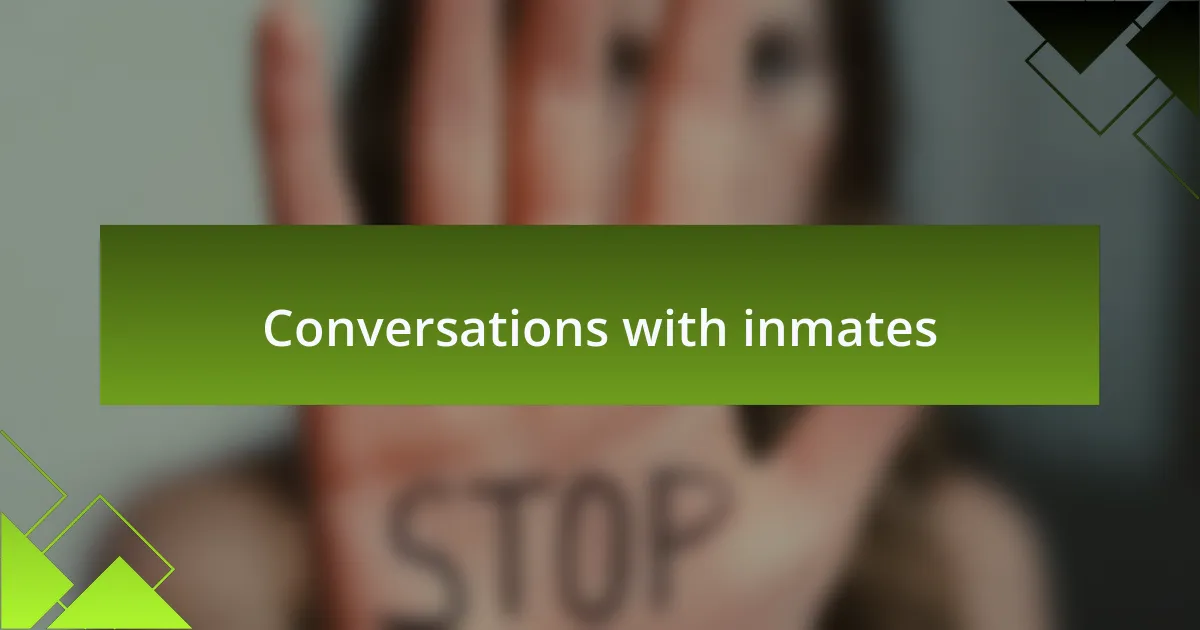
Conversations with inmates
Conversations with inmates were perhaps the most challenging yet enlightening part of my visit. As I sat down with one individual in a stark, small room, the palpable tension was almost suffocating. He looked at me with eyes that seemed to carry the weight of a thousand regrets. I listened intently as he spoke about his family, his dreams, and the mundane aspects of life that now felt so distant. I couldn’t help but think—what dreams die behind these walls?
Another inmate shared his thoughts on solitude, describing it as both a punishment and a space for reflection. He often journaled to escape the confines of his reality, transforming anguish into words. I marveled at the resilience of the human spirit, asking myself, how do some manage to find light amidst such darkness?
While some conversations brought heartbreak, others showcased unexpected warmth. One inmate cracked jokes about life in such austere surroundings, reminding me that humor can be a coping mechanism, even in the direst of situations. This made me reflect on the immense complexity of each individual’s journey—how they were not merely defined by their crimes but were multifaceted people navigating their circumstances. How do we reconcile these layers when judging someone’s life?

Reflections on the experience
Reflecting on my experience within the walls of a death-row facility, I often found myself grappling with conflicting emotions. One moment, I felt sorrow for the lives lost and the families shattered by their actions. In another, I recognized the humanity of the individuals I met—how their existence was defined far beyond the crimes they had committed. It was a poignant reminder that each person, regardless of their past, carries an intricate tapestry of experiences.
One encounter that particularly stuck with me was with a man who expressed profound remorse for his actions. As he spoke, I could see the genuine pain etched onto his face, a pain that seemed to reach beyond the confines of his cell. I couldn’t help but ask myself: how do we balance justice with empathy? This man’s sorrow was palpable, and I realized that while society often demands punishment, it also has a moral obligation to understand the underlying facets of a person’s life.
It’s fascinating, really, to contemplate the diverse perspectives shared by the inmates. While some painted grim pictures of despair, others spoke of hope and redemption. I was moved by the notion that even in the bleakest settings, aspirations lingered. Each reflection sparked a question in my mind: is it possible for someone to transform despite their surroundings? This journey into the heart of a death-row facility taught me that our understanding of life and justice can never be painted in black and white.